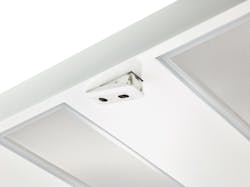Signify has introduced an all-in-one bundle of sensors for luminaires, aiming to make it easier for office managers to monitor and control indoor climate including temperature, humidity, and noise levels and to thus support a healthier physical work environment.
The matchbox-sized unit is designed to easily snap into Signify luminaires as part of the company’s Internet of Things (IoT) lighting scheme, called Interact Office. Data collected by the sensors travels either via Zigbee wireless or via Ethernet cables — depending on the user configuration — to a central dashboard from which operators can adjust settings.
The bundle includes an occupancy sensor which communicates whether or not someone is in a room, and a separate people-counting sensor. A temperature sensor takes readings at desk level, even with the bundle residing on the ceiling. Other sensors detect light levels, humidity, and noise. The noise sensor is new to Signify, as is the people counter and the ability to gauge temperature at desk level. The company’s previous standalone temperature sensors measured heat at ceiling level when mounted at that height.
A Bluetooth communications chip in the bundle can support location-based services as an option.
“Bundling and delivering these sensing capabilities into one unit eliminates the need for multiple sensors and is also much more cost effective for businesses.” a Signify spokesperson said. “The ability to differentiate the office working experience can help to create a healthy place to work, and help organizations reduce absenteeism.”
Although the bundle fits into a ready-made port on Signify office luminaires, it can also reside elsewhere.
In the Zigbee version, the lights and sensors are powered by standard electrical cabling. Information collected by the sensors is transmitted wirelessly via a meshed Zigbee network to a gateway wired to the office data network.
In the Ethernet version, electricity travels via Ethernet cable to the luminaire and sensors, using Power over Ethernet (PoE) technology. Data travels back over the same cable to the central control point.
A Bluetooth communications chip in the bundle can support location-based services as an option in either the Zigbee or PoE models. The Bluetooth is not used to transmit information back to a central server. The choice of Zigbee as the “backhaul” marks a victory round for the technology, which is vying against other wireless methods including Bluetooth, Wirepas, and others to play the heavyweight role in lighting-based networking schemes. Signify has a history of preferring Zigbee.
Signify said The Edge office building in Amsterdam is considering deploying the new sensor bundles as a means of enhancing employee health. The Edge pioneered PoE lighting from Signify — then called Philips Lighting — over 5 years ago, back in November 2014.
“Edge has worked with Signify from the first disruptive power-over-ethernet LED in The Edge building,” said Edge chief technology officer Erik Ubels, who noted that the new environmental monitoring capabilities could provide “an additional contribution to our employees’ wellbeing.”
Signify did not reveal pricing for the bundle.
MARK HALPER is a contributing editor for LEDs Magazine, and an energy, technology, and business journalist ([email protected]).






